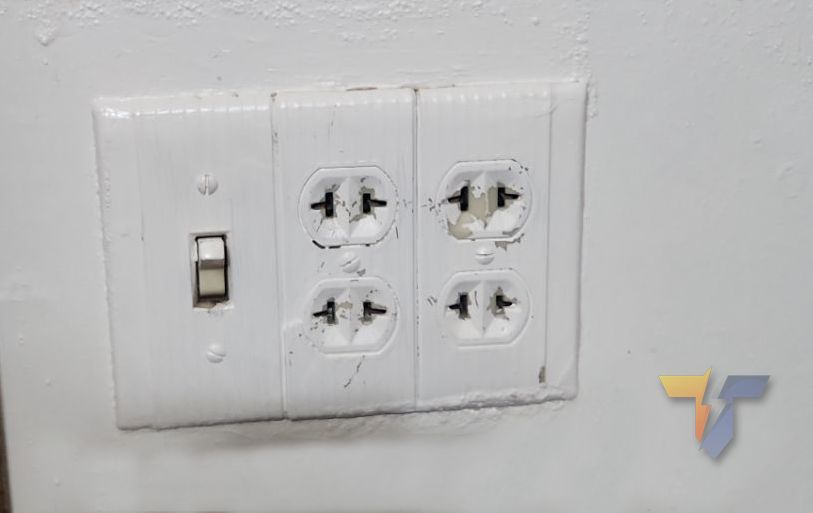Published by T.A.P. Electric (Southeast Iowa & West-Central Illinois Electrical Contractor)
If you live in an older home in Southeast Iowa or West-Central Illinois, you know the frustration of having 2-prong electrical outlets. These ungrounded receptacles prevent you from plugging in modern electronics, but more critically, they pose a serious shock and fire hazard.
The ground wire is the most important safety feature in your electrical system. When you decide to upgrade your home’s outlets, you have a few options. However, as your local, trusted electricians at T.A.P. Electric, we want to walk you through the three common paths and explain the differences.
The Core Problem: Why 2-Prong Outlets Are Dangerous
A 2-prong outlet lacks a dedicated grounding path. The third hole (the ground) is designed to provide an immediate, safe path for electricity to travel in the event of a fault. Without it, the electricity may travel through the appliance, surrounding metal or worst of all, you. A ground fault will travel through all metal parts, energizing them since there is no path to ground.
The Three Paths to a 3-Prong Outlet
Homeowners often consider these three methods to achieve a grounded, 3-prong receptacle:
1. The Code-Compliant & Permanent Solution: Complete Rewiring
The T.A.P. Electric Recommended Path
The gold standard for safety and code compliance is installing new, properly grounded wiring. This involves running a new cable (containing hot, neutral, and a dedicated ground wire) from your panel or junction box to the new 3-prong receptacle.
Why This is the Only True Fix:
- Maximum Safety: It provides the permanent, low-resistance path required to safely trip the breaker during an electrical fault.
- Appliance Longevity: It protects sensitive electronics, which often rely on a stable ground for internal safety systems.
- Home Value: Ensures your electrical system meets modern safety standards, a huge selling point in Southeast Iowa and West-Central Illinois homes.
2. The Life-Saving Compromise: GFCI Protection
If running new wires isn’t immediately feasible, the National Electrical Code (NEC) allows for a special alternative that provides shock protection: installing a GFCI (Ground-Fault Circuit Interrupter) receptacle.
What the Code Says (2020 NEC Article 406.4(D)(2))
According to the NEC, you may replace an ungrounded 2-prong receptacle with a GFCI receptacle, even if no ground exists. The GFCI protects people by monitoring the current flow and tripping if it detects a dangerous imbalance (a ground fault, meaning electricity is flowing somewhere it shouldn’t, potentially through a person).
Crucial Requirement: The GFCI receptacle must be clearly marked with the following labels:
- “No Equipment Ground”
- “GFCI Protected”
While a GFCI protects against shock, it does not protect electronics from surge damage, as it still lacks a true grounding path for the equipment. This is why we still recommend a full rewire when possible.
The Danger of GFCI “Converter” Misuse
Homeowners sometimes incorrectly replace the GFCI with a standard 3-prong receptacle down the line. If a 3-prong outlet is installed without a ground wire—even if protected by an upstream GFCI—it is highly misleading and dangerous. A 3-prong outlet must be grounded, or clearly labeled No Equipment Ground if protected by a GFCI.
3. The Impractical Path: Running a Separate Ground Wire
Another code-compliant method involves running only a separate ground wire (known as an EGC or Equipment Grounding Conductor) from the existing ungrounded receptacle back to the panel or another suitable grounding point.
Why T.A.P. Electric Finds This Impractical:
- Labor Intensive: You still have to open walls and pull wire, which requires nearly the same effort as running a whole new cable (hot, neutral, and ground).
- Compatibility: Old wiring might not be rated for modern loads, and attempting to mix old and new wiring components can lead to future complications and troubleshooting nightmares.
- Cost vs. Value: For the amount of effort required, the long-term value and safety provided by a complete rewiring (Path 1) far outweigh this option.
The Safety Trap: NEVER Use 2-to-3 Prong Adapters
A common DIY mistake is using a simple 2-to-3 prong converter or just replacing the 2-prong with an ungrounded 3-prong receptacle. These are extremely dangerous.
| Safety Hazard | Description |
| False Security | You plug in a modern appliance thinking it’s safe because it fits, but the ground pin is simply dead, offering no protection. |
| Shock/Fire Risk | If a fault occurs, the current has nowhere to go but through the metal or worse, the user. |
| The “Cheater Plug” Danger | 2-to-3 prong “cheater” adapters often rely on a small metal tab meant to be screwed into the yoke or cover plate screw. This is virtually never a reliable ground path and fails under fault conditions. |
The Code Verdict on Cheater Plugs
The use of these adapters violates modern safety standards and should be avoided entirely. They give the illusion of safety while leaving your home and family exposed to serious electrical hazards.
Call T.A.P. Electric for Safe Electrical Upgrades
Your safety is our priority. While the lure of a quick fix is strong, only a dedicated ground provides true protection.
If you are dealing with ungrounded outlets in Southeast Iowa or West-Central Illinois, let the licensed professionals at T.A.P. Electric provide you with a detailed, code-compliant plan. We specialize in safely upgrading older homes, ensuring your electrical system is ready for the future.
Don’t risk your family’s safety or your home’s integrity—get it done right.
Click here to Schedule a Rewiring Estimate with T.A.P. Electric Today!
[www.tap-electric.com]
309-333-3912
